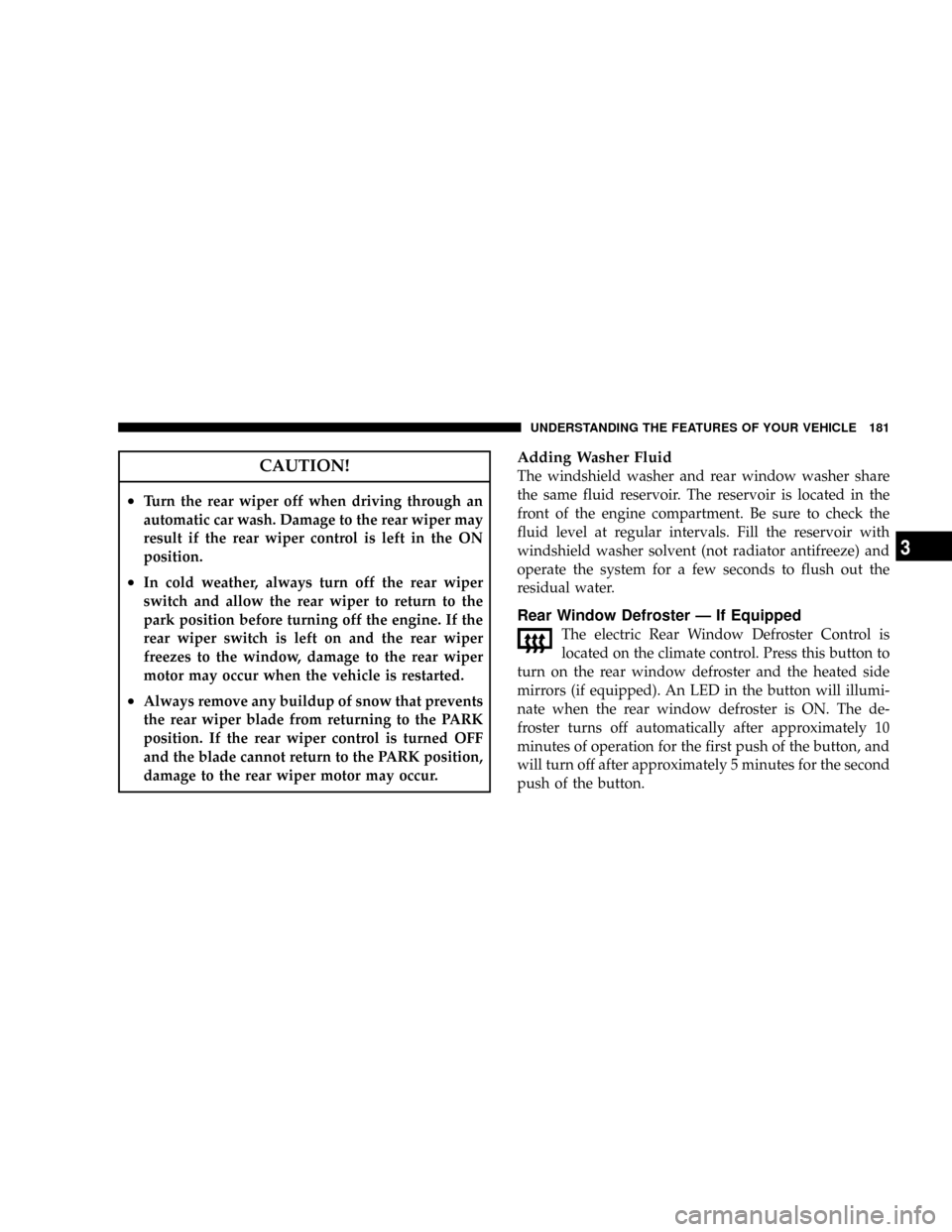2008 JEEP LIBERTY engine
[x] Cancel search: enginePage 181 of 493

CAUTION!
²Turn the rear wiper off when driving through an
automatic car wash. Damage to the rear wiper may
result if the rear wiper control is left in the ON
position.
²In cold weather, always turn off the rear wiper
switch and allow the rear wiper to return to the
park position before turning off the engine. If the
rear wiper switch is left on and the rear wiper
freezes to the window, damage to the rear wiper
motor may occur when the vehicle is restarted.
²Always remove any buildup of snow that prevents
the rear wiper blade from returning to the PARK
position. If the rear wiper control is turned OFF
and the blade cannot return to the PARK position,
damage to the rear wiper motor may occur.
Adding Washer Fluid
The windshield washer and rear window washer share
the same fluid reservoir. The reservoir is located in the
front of the engine compartment. Be sure to check the
fluid level at regular intervals. Fill the reservoir with
windshield washer solvent (not radiator antifreeze) and
operate the system for a few seconds to flush out the
residual water.
Rear Window Defroster Ð If Equipped
The electric Rear Window Defroster Control is
located on the climate control. Press this button to
turn on the rear window defroster and the heated side
mirrors (if equipped). An LED in the button will illumi-
nate when the rear window defroster is ON. The de-
froster turns off automatically after approximately 10
minutes of operation for the first push of the button, and
will turn off after approximately 5 minutes for the second
push of the button.
UNDERSTANDING THE FEATURES OF YOUR VEHICLE 181
3
Page 192 of 493

CAUTION!
The TPMS has been optimized for the original
equipment tires and wheels. TPMS pressures and
warning have been established for the tire size
equipped on your vehicle. Undesirable system opera-
tion or sensor damage may result when using re-
placement equipment that is not of the same size,
type, and/or style. Aftermarket wheels can cause
sensor damage. Do not use aftermarket tire sealants
or balance beads if your vehicle is equipped with a
TPMS, as damage to the sensors may result. (Refer to
ªTire Inflation Pressuresº under ªTires Ð General
Informationº and to ªTire Pressure Monitor System
(TPMS)º in Section 5 of this manual for more
information).5. Electronic Throttle Control (ETC) Warning Light Ð
If Equipped
This light informs you of a problem with the
Electronic Throttle Control system. If a problem
is detected, the light will turn on while the
engine is running. If the light remains lit with
the engine running your vehicle will usually be drivable
and not need towing, however see your authorized
dealer for service as soon as possible.
If the light is flashing when the engine is running, you
may experience power loss, an elevated/rough idle, and
increased brake pedal effort, and your vehicle may
require towing. Immediate service is required.
The light will turn on when the ignition switch is first
turned ON, and remain on briefly as a bulb check. This is
normal. If the light does not turn on during starting, have
the system checked by an authorized dealer.
192 INSTRUMENT PANEL AND CONTROLS
Page 193 of 493

6. Malfunction Indicator Light
This light is part of an onboard diagnostic system
called OBD that monitors emissions, engine, and
automatic transmission control systems. The light
will turn on when the key is in the ON position before
engine start. If the light does not turn on when turning
the key from LOCK or ACC to ON, have the condition
checked promptly.
Certain conditions such as a loose or missing gas cap,
poor fuel quality, etc. may turn on the light after engine
start. The vehicle should be serviced if the light stays on
through several of your typical driving cycles. In most
situations, the vehicle will drive normally and it will not
require towing.
If the Malfunction Indicator Light flashes when the
engine is running, serious conditions may exist that
could lead to immediate loss of power or severe catalyticconverter damage. The vehicle should be serviced as
soon as possible if this occurs. (See page 399 for more
information.)
CAUTION!
Prolonged driving with the MIL on could cause
damage to the engine control system. It also could
affect fuel economy and driveability.
If the MIL is flashing, severe catalytic converter
damage and power loss will soon occur. Immediate
service is required.
7. High Beam Indicator Light
This light shows that the headlights are on high
beam. Pull the Multi-Function Control Lever on
the left side of the steering column toward you to switch
to Low beam. (See page 133 for more information.)
INSTRUMENT PANEL AND CONTROLS 193
4
Page 195 of 493

13. Oil Pressure Warning Light
This light shows low engine oil pressure. The light
will turn on and remain on when the ignition
switch is turned from the LOCK or ACC position to the
ON position. The light will turn off after the engine is
started. If the light does not turn on during starting, have
the system checked by an authorized dealer.
If the light turns on and remains on while driving, safely
bring the vehicle to a stop and shut off the engine. DO
NOT OPERATE THE VEHICLE UNTIL THE CAUSE IS
CORRECTED.
This light does not show the quantity of oil in the engine.
The engine oil level must be checked using the proper
procedure. (See page 403 for more information.)
14. Anti-Lock Brake Warning Light
This light monitors the Anti-Lock Brake Sys-
tem. This light will turn on when the ignition
switch is turned to the ON position and it may
stay on for approximately 3 seconds.If the light remains on or turns on during driving, it
indicates that the Anti-Lock portion of the brake system
is not functioning and that service is required. However,
the conventional brake system will continue to operate
normally, provided the BRAKE warning light is not on.
If the ABS light is on, the brake system should be serviced as
soon as possible to restore the benefit of Anti-Lock Brakes.
The ABS Warning light should be checked frequently to
assure that it is operating properly. Turn the ignition
switch to the ON position, but do not start the vehicle.
The light should turn on. If the light does not turn on,
have the system checked by an authorized dealer. (See
page 310 for more information.)
15. Tachometer
This gauge measures engine revolutions-per-minute
(rpm x 1000). Before the pointer reaches the red area, ease
up on the accelerator to prevent engine damage.
INSTRUMENT PANEL AND CONTROLS 195
4
Page 197 of 493

cluster comes on when the ignition switch is turned to the
ªONº position. It should go out with the engine running.
If the ªESP/BAS Warning Lampº comes on continuously
with the engine running, a malfunction has been detected
in either the ESP or the BAS system, or both. If this light
remains on after the several ignition cycles, and the
vehicle has been driven several miles at speeds greater
than 30 mph (48 km/h), see your authorized dealer as
soon as possible to have the problem diagnosed and
corrected.(See page 314 for more information.)
NOTE:The ªESP/BAS Warning Lampº comes on mo-
mentarily each time the ignition switch is turned ON.
NOTE:Each time the ignition switch is turned ON, the
ESP System will be ON even if it was turned off previ-
ously.
NOTE:The ESP Control System will make buzzing or
clicking sounds when it is active. This is normal; thesound will stop when the ESP becomes inactive following
a maneuver that caused the ESP activation.
21. SERV (Service) 4WD Indicator Light Ð If Equipped
The ªSERV 4WD Indicator Lightº will turn on
when the ignition key is turned to the ON
position and it will stay on for 2 seconds. If the
light stays on or turns on during driving, it
means that the 4WD system is not functioning properly
and that service is required.
22. Coolant Temperature Warning Light
This light warns of an overheated engine condi-
tion. If the light turns on while driving, safely pull
over and stop the vehicle. If the air conditioner is
on, turn it off. Also, shift the transmission into ªNº
(Neutral) and idle the vehicle. If the temperature reading
does not return to normal, turn the engine off immedi-
ately and call for service. (See page 384 for more infor-
mation.)
INSTRUMENT PANEL AND CONTROLS 197
4
Page 198 of 493

NOTE:As the coolant temperature gauge approaches
9H,9this indicator will illuminate and a single chime will
sound. Further overheating will cause the temperature
gauge to pass9H.9In this case, the indicator will flash
continuously and a continuous chime will sound, until
the engine is allowed to cool.
CAUTION!
Driving with a hot cooling system could damage
your vehicle. If the temperature gauge reads ªH,º
pull over and stop the vehicle. Idle the vehicle with
the air conditioner turned off until the pointer drops
back into the normal range. If the pointer remains on
the ªH,º and you hear continuous chimes, turn the
engine off immediately, and call for service.
WARNING!
A hot engine cooling system is dangerous. You or
others could be badly burned by steam or boiling
coolant. You may want to call a service center if your
vehicle overheats. If you decide to look under the
hood yourself, see Section 7 of this manual. Follow
the warnings under the Cooling System Pressure Cap
paragraph.
23. Coolant Temperature Gauge
The temperature gauge indicates engine coolant tem-
perature. Any reading within the normal range indicates
that the cooling system is operating satisfactorily. The
gauge pointer will likely indicate a high temperature
when driving in hot weather, up mountain grades, in
heavy traffic, or when towing a trailer. If the pointer rises
to the ªHº mark, safely pull over and stop the vehicle. If
198 INSTRUMENT PANEL AND CONTROLS
Page 199 of 493

the air conditioner is on, turn it off. Also, shift the
transmission into ªNº (Neutral) and idle the vehicle. If
the needle remains on the ªHº mark, turn the engine off
immediately and call for service. (See page 384 for more
information.)
NOTE:The gauge pointer will remain near its last
reading when the engine is turned off. It will return to a
true reading when the engine is restarted.
CAUTION!
Do not leave your vehicle unattended with the en-
gine running, as you would not be able to react to the
temperature indicator if the engine overheats.24. Transmission Temperature Warning Light Ð If
Equipped
This light indicates that the transmission fluid
temperature is running hot. This may occur
with severe usage, such as trailer towing. If this
light turns on, safely pull over and stop the
vehicle. Then, shift the transmission into ªNº (Neutral)
and run the engine at idle or faster until the light turns
off.
25. Trip Odometer Button
Changing the Display
Press and release this button once to change the display
from odometer to ªTrip A.º Press and release it again to
change the display from ªTrip Aº to ªTrip B.º On vehicles
equipped with a Base Cluster, press and release it once
again to display the outside temperature. On vehicles
equipped with a Mid Line Cluster, press and release it
INSTRUMENT PANEL AND CONTROLS 199
4
Page 201 of 493

NOTE:If the instrument cluster is equipped with the
optional Electronic Vehicle Information Center (EVIC),
then most warnings will display in the EVIC. (See page
206 for more information.)
Fuel Cap Fault Message
If the vehicle diagnostic system determines that the fuel
filler cap is loose, improperly installed, or damaged, the
words ªgASCAPº will display in the odometer. If this
occurs, tighten the fuel filler cap properly and press the
odometer reset button to turn off the message. If the
problem continues, the message will appear the next time
the vehicle is started.
A loose, improperly installed, or damaged fuel filler cap
may also turn on the Malfunction Indicator Light (MIL).
(See page 399 for more information.)Change Oil Message (Base & Mid Line Clusters Only)
Your vehicle is equipped with an engine oil change
indicator system. The ªCHANgE OILº message will flash
in the instrument cluster odometer for approximately 12
seconds after a single chime has sounded to indicate the
next scheduled oil change interval. The engine oil change
indicator system is duty cycle based, which means the
engine oil change interval may fluctuate dependent upon
your personal driving style.
Unless reset, this message will continue to display each
time you turn the ignition switch to the ON position. To
turn off the message temporarily, press and release the
Trip Odometer button on the instrument cluster. To reset
the oil change indicator system (after performing the
scheduled maintenance) perform the following proce-
dure:
1. Turn the ignition switch to the ON position (Do not
start the engine).
INSTRUMENT PANEL AND CONTROLS 201
4